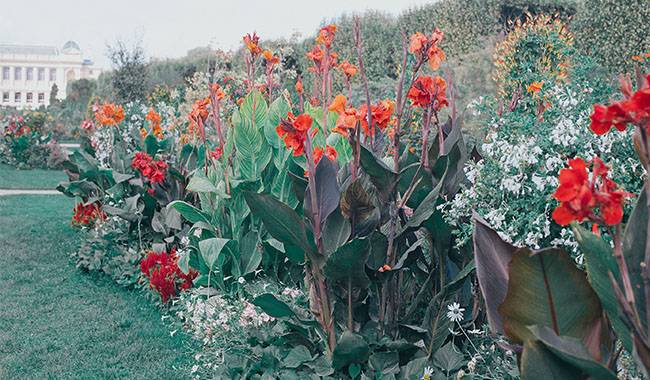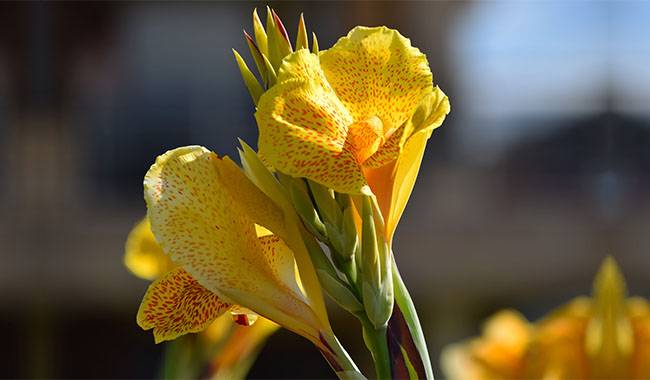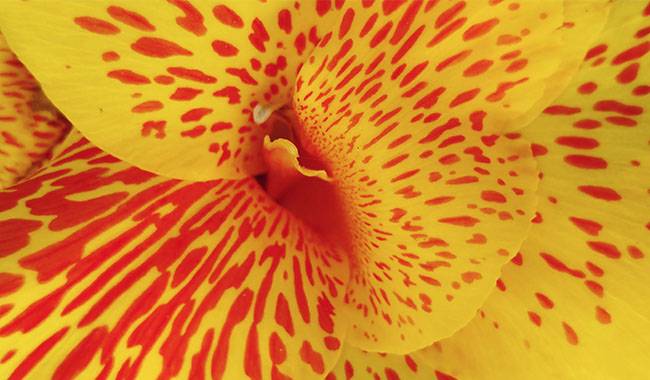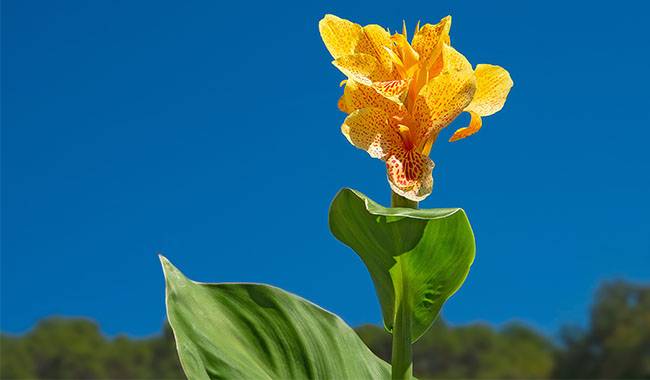
WHAT IS CANNA (PLANT)?
The genus Canna (scientific name: Canna L.): is a genus of the lily family, order Ginger, family Cannaceae. It is a perennial herb with tuberous rhizomes. With rhizomes, also with erect stems up to 3 meters high. Leaves green or bronze, spirally arranged.
Flowers asymmetrical, with only one developing stamen, half of this stamen with developing anther locules, the other half petaloid, several staminodes, one revolute or labellum outward, the rest petaloid, with three true petals.
The flowers are colorful and rich, with deep red, pink, bright yellow, milky white, yellow background decorated with red dots, or deep red with gold edges, etc.; its leaves resemble canna, dark green, some varieties are reddish-brown, with white powder, distinctive.
Sometimes the flowers and leaves have different color spots.
Strong, adaptable, almost no choice of soil, with a certain degree of cold tolerance. In the origin of the non-dormant, annual growth and flowering, sex like warm and hot climate, good sunshine, and moist fertile deep soil.
It grows in ravines, valleys, forest slopes, village roadsides, etc. at an altitude of 4-2700 meters, and individual species such as pink canna can grow in swampy environments. This family is widely cultivated for ornamental purposes. Most of them are found in the Western Hemisphere.
These plants have lush stems and leaves, large and colorful flowers, and a long flowering period, making them suitable for large natural plantings, flower beds, flower borders, and basic cultivation. Low-growing varieties can be used as potted ornamental plants, and canna species are also good for purifying the air and are more resistant to harmful gases.
Some species also have economic value. For example, the rhizomes of canna roots are rich in starch and can be eaten. The rhizomes and flowers of canna can be used as medicine to clear heat, calm the mind, and lower blood pressure.
DEVELOPMENT HISTORY
The history of the origin and development of canna species, mainly from 1848 to the 21st century, has gone through four historical periods.
In 1848, Année, a French horticulturist, used C. indica and C. glauca as parental crosses to produce C. x Anneli, and later, C. x discolor a round-leaved canna. Ehemann produced C. ehemann in 1863 by using C. irtaiflora and C. warscwiczii as parental crosses.
The birth of the three original hybrids resulted in significant improvements in ornamental traits, such as a reduction in plant height from 360-390 cm (11.8-12.7 feet) to 120-180 cm (3.93-5.9 feet), an increase in leaf color from green only to purple-red, and an increase in flower color from red to orange-yellow. However, the flowers are still small and incomparable to contemporary cultivars. [6]
During the birth of Croxy Cannas (1863-1868), horticultural breeders such as French horticulturists Crazy and Vilmorin, British Paul and Son, and American Wintzer, used canna, pink canna, pendant canna, purple-leaved canna In 1868, Cruz took the lead in producing the first batch of excellent hybrid canna and named it Croxy Cannas, and later produced French Draw Cannas and Acorus calamus. The main advantage of these hybrids is that they are not only the most popular but also the most popular. The main advantage of these hybrid bananas is that the diameter of the flowers has increased significantly.
During the birth of Italian Cannas (1868-1893), Sprenger, an Italian horticulturist, and Burbank, an American horticulturist, used interspecific crosses between Cruz’s canna and yellow-flowered canna to produce the first Italian Cannas in 1893. Cannas, whose flowers are larger than those of the Cruz canna, reaching a diameter of more than 20cm (7.87inch), with orchid-shaped flowers.
As the breeding work progressed, a large number of excellent varieties of canna came out and were used more and more commonly, and people became more enthusiastic about canna plants, thus promoting the breeding work again.
From 1893 to 1898, large-scale hybrid breeding of canna was started in Europe and America. After that, the use of radiation mutagenesis breeding also obtained many excellent varieties.
TAXONOMIC STUDIES
Because of the complex parental origin of most canna species, the kinship between varieties is less reflected in taxonomic studies, and the traits of flower shape and size are used as the basis for developing the classification system.
Bailey (USA) classified all hybrid cannas into two-hybrid systems, large-flowered canna, and orchid canna, based on the parental class and morphological characteristics of the varieties.
Indian Persia et al. classified the varieties of the genus canna into eight types based on flower shape and size: Cruz type, Don Calamus type, Aleppo type, large-flowered or orchid type, fearless type, short cluster type, candelabra type, and mini type.
In addition, there are also cultivars of the genus canna classified as terrestrial canna and aquatic canna according to the way they are cultivated in the world.
The research on the introduction and selection of canna in China has been carried out in the 1980s and has achieved some success.
Nearly 100 species of canna have been collected in China, and research on the classification of canna species has been carried out accordingly.
Tan Guangwen (1987) and others used the binary classification method to classify 44 species of canna and established a preliminary classification system, firstly, leaf color was used as the first level criterion to classify the green leaf group and purple leaf group, then the plant height was used as the second level criterion to classify the tall, medium and short types, then the width of the penalized stamens was used as the third level criterion to classify the narrow and broad petals, and finally, the flower color was used as the fourth level criterion to classify the narrow and broad petals. Finally, the flowers were divided into the monochromatic group, bicolor group, spotted groups, muddy color group,s, and colored edge group according to the flower color as the fourth level criterion.
According to this classification system, 44 varieties are divided into 2 groups, 3 types, 2 categories, and 5 groups. The most important feature of this classification system is that it reflects both evolutionary relationships and the practical morphology of varieties.
MORPHOLOGICAL CHARACTERISTICS
The genus Melaleuca is a perennial, erect, stout herb.
It has tuberous underground stems. The leaves are large, alternate, with distinct pinnate parallel veins and a leaf sheath.
Flowers bisexual, large, beautiful, asymmetrical, in terminal spikes, racemes or narrow panicles, bracteate; sepals 3, green, persistent; petals 3, calyx-like, usually lanceolate, green or other colors, connate proximally into a tube and often conjoined with a staminode cluster.
Staminodes petaloid, basally connate, the most beautiful and conspicuous part of the flower, red or yellow, 3-4, 3 (sometimes 2 or none) larger in the outer whorl, 1 narrower in the inner whorl, externally reversed, called labellum.
The filaments of the developing stamens are also enlarged and petal-like, ± convoluted, with a 1-loculed anther locule at the margin, basally or half united with the enlarged style; the ovary is inferior, 3-locule, with many ovules per locule; the style is flattened or rod-shaped. The fruit is a capsule, 3-valved, ± 3-angled, with small tubercles or soft spines; the seeds are spherical.
The flowers are pretty and richly colored, including deep red, pink, bright yellow, cream, yellow with red dots, or deep red with gold edges, etc. The leaves resemble canna, dark green, and some varieties are reddish-brown with white powder, which is distinctive.
GROWING ENVIRONMENT
It grows in ravines, valleys, forest slopes, village roadsides, etc. at an altitude of 4-2700 meters, and individual species such as pink canna can grow in swampy environments. The fossil evidence of Precambrian canna leaves shows that Peru and Suriname in South America are the original centers of the canna family.
DISTRIBUTION RANGE
Canna plants are naturally distributed in the Neotropical and subtropical regions, i.e. from Central America to the West Indies to South America, between 30 degrees north and south latitude, in countries and regions including Florida, Panama, Cuba, Colombia, Nicaragua, Suriname, Brazil, etc.
At least one to three species in the genus canna originated in Africa or Asia. In the past, it was believed that wild canna (C. indica L.) also existed in China, with green stems and leaves, not powdered, small and vermilion corolla and staminodes, (and apricot-yellow variant), which was thought to be pantropical and native to India, but in fact, it was not well-founded.
The canna (C. Indica L.) is probably the ancestral type of the genus, originally widespread in the pantropical region, with early origins during the first pantropical Pacific expansion. Because of the high ornamental value of most C. Indica plants, have been widely introduced and cultivated throughout the world, including Europe, Asia, Africa, and Oceania.
CANNA SPECIES
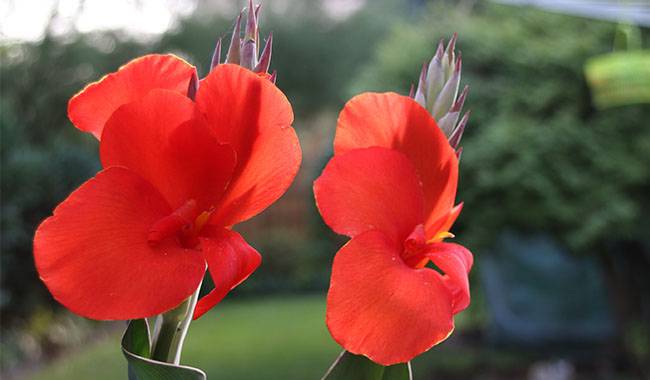
canna (Canna indica)
Pink canna (Canna glauca)
Canna flaccida
Canna iridiflora
Orange canna (Canna aurantiaca)
Banana taro (Canna edulis)
Lillian (lilian cole)
Canna warscowiczii (purple-leaved canna)
Alberich
Alaska
Aida
Cannova rose
Alex Cole
Alsace
Portland (Portland)
Champagne (champagne)
Capricornia (capricornia)
Hibiscus (hibiscus)
Illusion (evolution)
Egg flower (frangipani)
Cupid (cupid)
Vulcan (fire magic)
King of Siam (king of siam)
Tulip (edna tulip)
Crepe orange (crepe orange)
Berkman (p.j.berkman)
Cleopatra (Cleopatra)
Cleopatra (Cleopatra)
Pretty rose (rosea superba)
Rosemond (rosemond cole)
Natty (nattie cole)
Milk peach (peaches n cream)
Pandora (pandora)
Wyoming (Wyoming)
Philip (philip)
Ginger taro (Achira)




